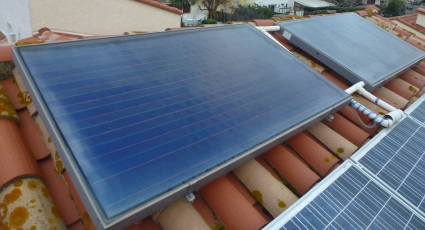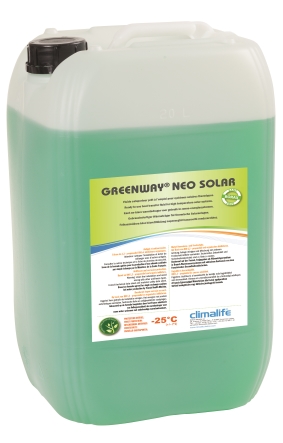Faced with serious deterioration of the installation, he decided to call upon the expertise of Climalife. A successful partnership when it comes to resolving extreme situations !
The circumstances
A 10-year-old individual solar water heater located in the south of France requires just over 10 litres of coolant.
When the pump broke, the installer thought it had damaged the fluid because it was not circulating any more. So he took a sample of the fluid and sent it to Climalife’s laboratory for analysis (APC B : appearance + freezing point + density at 20°C + alkalinity reserve + pH), assessment of the deterioration and then interpretation of the results.
Analysis results of the old coolant showed a tar residue and a deterioration of the fluid so it had to be removed and replaced with a more suitable one.
* Note: the degradation of MPG-based fluids is irreversible above 160°C.
Step 1: emptying the installation
The installer opened the drain valve on the solar system and ran the circulation pump. To drain out the remaining fluid stuck at low points, a filling pump was connected to the installation and water passed through it until the liquid exiting the drain valve ran clear.
We should point out here that an installation should never be left empty in a damp atmosphere, in order to prevent the corrosion that could quickly form on sensitive materials (copper, brass, etc.). Actually, coolant fluids have a wetting ability that can cause corrosion debris to detach running the risk of blocked valves and pipework. If the installation cannot be filled immediately after draining and rinsing with new heat transfer fluid, it is better to leave it filled with clean water, while awaiting refilling.
Step 2: tar removal
Once the old thermal fluid had been drained out, the installer filled the filling pump reservoir with SolRnett cleaner and circulated it around the system for 30 minutes.
This technical fluid – which complies with current regulations – is an effective tar remover for cleaning solar circuits where the flow has slowed down due to the coolant fluid thickening (which often happens when the system is switched off for several weeks. The sun heats up the coolant, which is no longer circulating and causes it to rise to very high temperatures. This causes it to deteriorate and form tar).
 Ready to use SolRnett is an aqueous fluid, based on wetting, organic solvents and slightly alkaline agents. It is water soluble, non-foaming and provides an easy rinsing solution. It eliminates all deposits of deteriorated heat transfer fluid which could cause blockages or reduce flow rates.
Ready to use SolRnett is an aqueous fluid, based on wetting, organic solvents and slightly alkaline agents. It is water soluble, non-foaming and provides an easy rinsing solution. It eliminates all deposits of deteriorated heat transfer fluid which could cause blockages or reduce flow rates.
It should be noted that it is also compatible with installation materials (metals and elastomers).
Once cleaned, the installation is drained to remove the “used” SolRnett.
This initial action alone can give an installation an immediate new lease of life… so long as it doesn’t leak, of course !
Step 3: filling with a suitable technical fluid
The installer then filled the installation with Greenway® Neo Solar and circulated it around the system for 5 minutes before degassing it. He then left it for 10 minutes, so that the dissolved gases condensed and were removed again. Then he ran it for another 5 minutes and degassed again. All the accumulated air in the circuit was therefore eliminated. It was then possible to pressurise the system.
It is worth pointing out that the installer was interested in Greenway® Neo and its environmental credentials, plus its excellent stability at high temperatures.
Conclusion
Close collaboration between the installer and Climalife ensured that things went smoothly.
The installation now has the benefit of preventative maintenance with a mandatory annual inspection and laboratory analysis of the fluid (with the APC kit that includes an identification sheet, a bottle for taking the sample on site and a pre-paid postal envelope).
For the end customer, the noise reduction, longevity of the equipment (no more struggling pump), greater efficiency (appropriate flow rate ensured) and a guaranteed return on the investment in its solar installation, are all really positive credentials !
Note :
A heat transfer fluid that deals with the stresses placed on an installation should be recommended, to avoid any loss of system efficiency due to reduced heat transfer.


